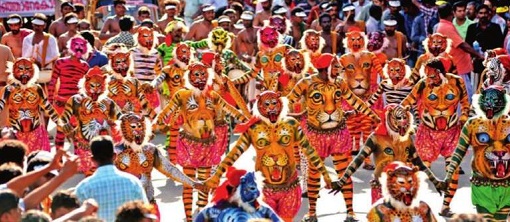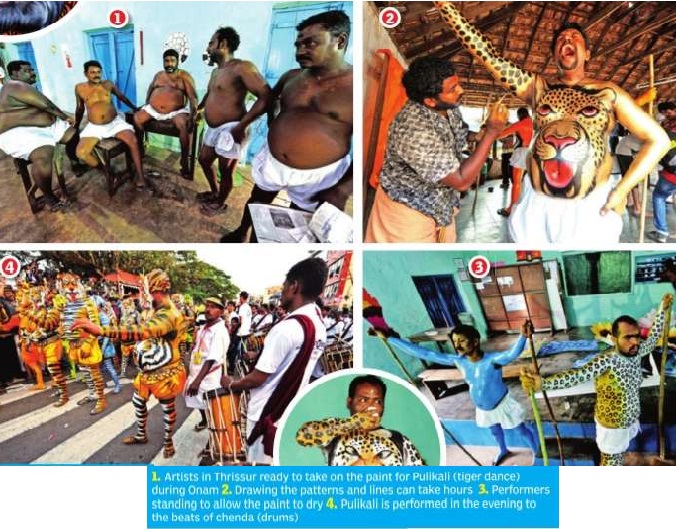Thrissur Pulikali (Tiger dance)


This is a collection of articles archived for the excellence of their content. |
History
The Times of India, Sep 03 2015
B A Raju & M T Saju
Thrissur Pulikali (tiger dance) during Onam may be synonymous with big bellies, but artists say it is a latterday innovation meant to entertain audiences.
At a time when people work hard to reduce their waistlines, pro truding bellies are in demand here. The bigger the belly, the better the chance of displaying it in public in vibrant colours. On the fourth day of Onam in Thrissur, the belly becomes a symbol of majesty and ferocity through Pulikali (tiger dance). In Pulikali, a folk dance form prevalent in the central region of Kerala, the artist's belly becomes a tiger that wriggles and sways to the beat of the chenda (drum). Eight teams, each with 30 members, assembled in Thrissur on Monday for the annual Pulikali. The organizers start scouting for the artists bellies many weeks before Onam, says Anand PK, an expert in the art form.
A big belly pays well. “One can earn at least Rs7,000 for one performance if he has a great paunch,“ he adds.
Pulikali dates back more than 200 years.“It was the Cochin ruler, Sakthan Thampuran who introduced the art form to celebrate Onam. But the folk art form has undergone a lot of changes,“ said T R Antony, who performed his 38th Pulikali in Thrissur.
Though the tiger dance is old, the big belly is a latter-day innovation it makes Pulikali a spectacle. “Earlier we didn't use masks. Today we do. Even make-up has undergone a lot of changes,“ says Antony , who is 68 years old.
On the day of the `kali', the work of painting the bellies starts early . “The work starts in the morning for the evening event,“ said Anand.
First the artists apply egg-white on their bodies and walk around for an hour. Then they apply coconut oil and prepare for a bath. “After this, our skin is ready to take the paint. The lines can be drawn easily now,“ says Antony .
While Antony laments that the changes are destroying traditions, K Surendran, another artist, says today's audiences want fun and the bellies provide it. The dance is still there, he assures. “I am proud of my paunch and I maintain it well,“ says Surendran, who has been performing for ten years.
Threats
Shortage of funds
Mini Muringatheri, Thrissur’s Pulikali on the road to extinction, July 14, 2018: The Hindu’'
Kerala’s hallmark street art form is fading due to state apathy and shortage of funds
Two centuries ago, when tigers roamed Thrissur streets on the Chathayam day of Chingom, they did so in royal grandeur. It was majesty and power that Shakthan Thampuran probably intended to infuse into Kerala’s hallmark harvest festival when he introduced Pulikali, the tiger hunt–themed street art form that has men done up in tiger body art roaming the streets in a feral dance, well-aided by rustic drum beats.
Now, years later, the pomp is in place and even the gaiety, as Pulikali teams get on street on Chathayam day. But the shades of draining pride are more than conspicuous. The art form, which can proudly be called Thrissur’s own, is being ravaged mainly by financial crisis.
There are many teams that focus on the art form, but most of them are struggling to make ends meet, with expenses skyrocketing and fund flow in trickles. T.S. Sumesh of the Viyyur Centre Pulikkali Sangam says it is a tough time for the Pulikkali teams and many well-known teams have withdrawn from the scene over a period.
Unlike Thrissur Pooram, which is managed by Devaswoms, Pulikkali is managed by groups of youth who want to preserve the dying art form. From paint and thinner to fibre for making the masks and dresses, everything has become costly. Even the payment for the artistes has gone high, they say.
Funds shortage
Apart from aid from the city Corporation and the Tourism Department, major portion of Pulikkali fund comes from local people. The rest is from sponsors. Blame it on economic slowdown or GST, sponsors are increasingly hard to come by these days, complain the Pulikkali teams. They even pawn gold ornaments of their kin to raise fund. But often fall into debt traps, as cost exceeds the collection.
The acute financial crisis is further accentuated by the attitude of the Tourism Department towards the art form, say the Pulikali teams. While the art form should be flaunted as a flagship cultural event, it is grossly neglected by the department, they say.
“On an average, the expense for preparations for each team will touch around Rs. 15 lakh. The city Corporation is giving Rs. 1.5 lakh. But it will hardly suffice. Though the Tourism Department has been promising Rs. 1 lakh, it is not available on time,” says Sumesh. We are yet to get the fund for 2017 from the Tourism Department. Now it is already time for the preparations for 2018, he says. The department should keep a separate fund for Pulikkali, he adds.
If such an attitude and state-of-affairs continue, human tigers on the streets during Chathayam day will be as sparse as tigers in forests, lovers of the art form fear.